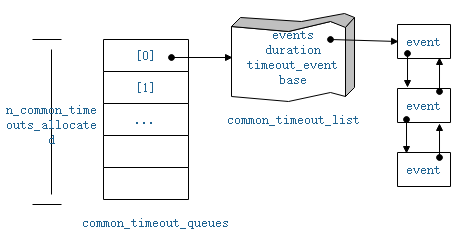libevent不仅支持io事件,同时还支持timeout事件与signal事件,这篇文件将分析libevent是如何组织timeout事件以及如何响应timeout事件。
1. min_heap
首先,event_base中有一个成员struct min_heap timeheap,这是一个最小堆,用来存储timeout事件的结构之一。先来看一下它的定义:
typedef struct min_heap { struct event** p; size_t n, a; } min_heap_t;
p是一个可以动态扩展的指针数组,数组长度为a,n表示堆成员数量,堆成员是指向event结构的指针。libevent中最小堆相关的操作定义在minheap-internal.h源码文件中,使用这些操作可以维持数组中的成员保持最小堆性质。
堆排序的依据是event结构中的成员ev_timeout,这个成员记录了事件超时的绝对时间(即超时时间点)。根据最小堆性质,堆顶元素总是最早超时的事件。
2. event_base_loop
使用min_heap的堆顶元素,libevent总是可以知道从现在起到有事件超时所需的时间tv,这个操作在event_base_loop中调用timeout_next函数完成。libevent处理io事件的后端接口,如select,都有一个时间参数作为阻塞的最长时间,将tv作为后端接口的入参,那么event_base_loop在循环中总是会在有事件超时之前被唤醒。唤醒后再循环检查min_heap的堆顶元素是否超时,超时则将它加入到event_base的待执行回调函数链表,这步操作在event_base_loop中调用timeout_process函数实现。如此即可实现超时事件的响应。
3. common_timeout_queues
仅使用min_heap成员,event_base已经足够管理timeout事件了,但是当有太多的timeou事件时,维持最小堆性质会成为一个耗时的操作。为解决这个问题,libevent使用了一个叫做common_timeout_list的结构,将超时时间相近的事件放到一起,这些事件在min_heap中仅留一个代表,减少min_heap的成员数量。common_timeout_list结构的定义如下(源码在event-internal.h中):
struct common_timeout_list { /* List of events currently waiting in the queue. */ struct event_list events; /* 'magic' timeval used to indicate the duration of events in this * queue. */ struct timeval duration; /* Event that triggers whenever one of the events in the queue is * ready to activate */ struct event timeout_event; /* The event_base that this timeout list is part of */ struct event_base *base; };
events是一个事件的双向链表,连接了所有属于这个common_timeout_list的超时事件,struct event结构中的成员ev_timeout_pos.ev_next_with_common_timeout正是用来构造这个链表;duration是一个带有特殊标记的时间戳(后面解释如何标记);timeout_event即是加入min_heap中的代表事件;base记录了归属的event_base结构。
event_base中可以存在多个common_timeout_lsit结构,它使用common_timeout_queues进行管理,这是一个动态扩展的指针数组,每一个成员都指向一个common_timeout_list结构,n_common_timeouts_allocated表示动态数组的长度,n_common_timeouts代表有效的成员数目,common_timeout_queues的结构可以用图3-1表示:
图3-1 common_timeout_queues结构
- 首先,common_timeout_list中的事件是按超时时间顺序排列的
- 然后,common_timout_lsit中有一个专职的事件timeout_event用来加入到min_heap中,它的超时时间是事件链表中最早的超时时间。timeout_event的回调函数也是特殊设计的,作用是遍历它归属的common_timeout_list上的事件链表,将超时的事件加入到event_base的待执行回调函数链表上。timeout_event的优先级被设置为0,在event_base_loop处理待执行回调函数时会优先执行,在它的回调函数中处理的超时事件加入的待执行回调函数链表优先级较低,因此这些事件的回调函数还可以在同一次event_base_loop循环中被执行。
类似timeout_event这种特殊事件被称为内部事件,类似的设计在libevent处理signal事件中也有用到。
common_timeout_list事件中timeval的特殊标记:
libevent设计了如下标记:
/** Mask used to get the real tv_usec value from a common timeout. */ #define COMMON_TIMEOUT_MICROSECONDS_MASK 0x000fffff #define MICROSECONDS_MASK COMMON_TIMEOUT_MICROSECONDS_MASK #define COMMON_TIMEOUT_IDX_MASK 0x0ff00000 #define COMMON_TIMEOUT_IDX_SHIFT 20 #define COMMON_TIMEOUT_MASK 0xf0000000 #define COMMON_TIMEOUT_MAGIC 0x50000000
所有common_timeout_list链表中的event的ev_timeout.tv_usec都会异或上值COMMON_TIMEOUT_MAGIC作为标识;并将这个common_timeout_lsit在common_timeout_queues数组中的索引记录在第21bit至28bit中;真正的tv_usec值只使用了COMMON_TIMEOUT_MICROSECONDS_MASK标记的比特位。
